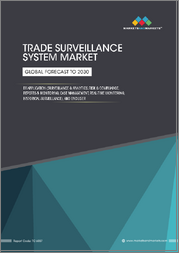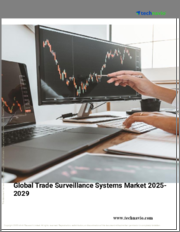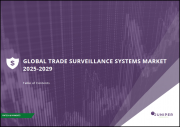
|
시장보고서
상품코드
1781401
세계의 무역 감시 시장 조사 보고서 : 산업 분석, 규모, 점유율, 성장, 동향 및 예측(2025-2033년)Global Trade Surveillance Market Research Report- Industry Analysis, Size, Share, Growth, Trends and Forecast 2025 to 2033 |
||||||
세계의 무역 감시 시장 규모는 2024년 12억 달러에서 2033년에는 40억 7,000만 달러에 이를 것으로 예측되며, 2026년에서 2033년의 예측 기간 동안 14.52%의 견조한 연평균 성장률(CAGR)을 나타낼 전망입니다.
금융 기관과 규제 기관이 점점 더 복잡해지는 거래 환경에서 규정 준수 및 위험 관리의 중요성을 인식함에 따라 무역 감시 시장은 패러다임의 변화를 겪고 있습니다. 고주파 거래 및 알고리즘 전략이 등장하면서 정교한 감시 시스템에 대한 필요성이 그 어느 때보다 절실해졌습니다. 이러한 시스템은 고급 분석 및 머신 러닝 알고리즘을 활용하여 이상 징후를 감지하고, 거래 패턴을 모니터링하며, 규제 요건을 준수하는지 확인합니다. 전 세계적으로 규제 심사가 강화됨에 따라 강력한 거래 감시 솔루션에 대한 수요가 급증하여 이 부문의 혁신과 투자가 촉진될 것으로 예상됩니다.
또한, 거래 감시 시스템에 인공 지능이 통합되면 그 효율성이 크게 향상될 것입니다. AI 기반 솔루션은 방대한 양의 거래 데이터를 실시간으로 분석하여 잠재적인 시장 조작, 내부자 거래 및 기타 불법 활동을 전례 없는 정확도로 식별할 수 있습니다. 이 기능은 규정 준수 프로세스를 간소화할 뿐만 아니라 기업이 새로운 위협에 사전에 대응할 수 있는 역량을 강화합니다. 금융 시장이 계속 진화함에 따라, 거래 감시 시장은 과거 데이터에서 학습하고 시간이 지남에 따라 탐지 능력을 향상시킬 수 있는 보다 적응력 있고 지능적인 시스템으로 전환될 가능성이 높습니다.
또한, 데이터 개인 정보 보호 및 보안에 대한 강조가 증가하면서 거래 감시의 미래가 형성되고 있습니다. 기업이 민감한 거래 데이터를 수집하고 분석함에 따라, 데이터 보호 규정을 준수하는 것이 가장 중요해졌습니다. 거래 감시 시장은 규제 기준을 충족할 뿐만 아니라 민감한 정보의 무결성을 보호하는 솔루션을 개발하여 이러한 과제에 적응해야 합니다. 시장이 진화함에 따라 이해 관계자들은 신흥 트렌드에 민첩하고 신속하게 대응해야 하며, 기술을 활용하여 감시 능력을 강화하고 급변하는 규제 환경에서 경쟁 우위를 유지해야 합니다.
이 보고서는 다양한 산업과 시장에 대한 종합적이고 실용적인 인사이트를 고객에게 제공하기 위해 세심한주의를 기울여 작성되었습니다.
시장 개요 : 정의, 분류, 업계 현황 등 시장에 대한 상세한 소개.
시장 역학 : 시장 성장에 영향을 미치는 주요 촉진요인, 억제요인, 기회, 과제를 상세하게 분석합니다.
세분화 분석 : 제품 유형, 용도, 최종 사용자, 지역 등의 기준에 따라 시장을 명확한 부문으로 분석합니다.
경쟁 환경 : 시장 점유율, 제품 포트폴리오, 전략적 이니셔티브 및 재무 성과를 포함한 주요 시장 업체에 대한 종합적인 평가. 이 부분에서는 주요 기업들이 채택한 경쟁 역학 및 주요 전략에 대한 인사이트를 제공합니다.
시장 예측 : 과거 데이터와 현재 시장 상황에 따라 일정 기간 동안 시장 규모와 성장 동향을 예측합니다.
지역 분석 : 지역별 시장 성과를 평가하고 주요 시장과 지역 동향을 밝힙니다.
새로운 동향과 기회 : 현재 시장 동향과 새로운 시장 동향, 기술 혁신, 잠재적인 투자 대상 분야를 파악합니다.
목차
제1장 서문
제2장 주요 요약
- 시장의 하이라이트
- 세계 시장 현황
제3장 무역 감시의 산업 분석
- 소개 : 시장 역학
- 시장 성장 촉진요인
- 시장 성장 억제요인
- 시장 기회
- 업계 동향
- Porter's Five Forces 분석
- 시장 매력 분석
제4장 밸류체인 분석
- 밸류체인 분석
- 원재료 분석
- 원재료 리스트
- 원재료 제조업체 리스트
- 주요 원재료의 가격 동향
- 잠재적 구매자 목록
- 마케팅 채널
- 직접 마케팅
- 간접 마케팅
- 마케팅 채널 발전 동향
제5장 세계의 무역 감시 시장 분석 : 컴포넌트별
- 컴포넌트별 개요
- 컴포넌트별 실적 데이터와 예측 데이터 분석
- 솔루션
- 서비스
제6장 세계의 무역 감시 시장 분석 : 배포 모델별
- 배포 모델별 개요
- 배포 모델별 실적 데이터와 예측 데이터 분석
- 클라우드
- 온프레미스
- 하이브리드
제7장 세계의 무역 감시 시장 분석 : 조직 규모별
- 조직 규모별 개요
- 조직 규모별 실적 데이터와 예측 데이터 분석
- 대기업
- 중소기업(SME)
제8장 세계의 무역 감시 시장 분석 : 업계별
- 업계별 개요
- 업계별 실적 데이터와 예측 데이터 분석
- 자본시장
- 은행 금융 서비스 및 보험(BFSI)
제9장 세계의 무역 감시 시장 분석 : 지역별
- 지역별 전망
- 소개
- 북미의 매출 분석
- 개요, 분석과 예측
- 북미 : 부문별
- 북미별
- 미국
- 캐나다
- 멕시코
- 유럽의 매출 분석
- 개요, 분석과 예측
- 유럽 부문별
- 유럽 국가별
- 영국
- 프랑스
- 독일
- 이탈리아
- 러시아
- 기타 유럽
- 아시아태평양의 매출 분석
- 개요, 분석과 예측
- 아시아태평양 부문별
- 아시아태평양 국가별
- 중국
- 인도
- 일본
- 한국
- 호주
- 동남아시아
- 기타 아시아태평양
- 라틴아메리카의 매출 분석
- 개요, 분석과 예측
- 라틴아메리카 : 부문별
- 라틴아메리카 국가별
- 브라질
- 아르헨티나
- 페루
- 칠레
- 기타 라틴아메리카
- 중동 및 아프리카의 매출 분석
- 개요, 분석과 예측
- 중동 및 아프리카 부문별
- 중동 및 아프리카 국가별 일람
- 사우디아라비아
- 아랍에미리트(UAE)
- 이스라엘
- 남아프리카
- 기타 중동 및 아프리카
제10장 무역 감시 기업경쟁 구도
- 무역 감시 시장의 경쟁
- 제휴, 협력 및 협정
- 합병 및 인수
- 신제품 발표
- 기타 개발
제11장 기업 프로파일
- 주요 기업의 시장 점유율 분석
- 시장 집중도
- Fidelity National Information Services Inc.(FIS)
- Fiserv Inc.
- Nasdaq Inc.
- Thomson Reuters Corporation
- NICE Actimize
- Software AG
- IPC Systems Inc.
- Scila AB
- Ancoa Software Ltd.
- B-Next
- Cinnober Financial Technology AB
- OneMarketData LLC
- Smarsh Inc.
- Aquis Technologies
- Eventus Systems Inc
Global Trade Surveillance Market size is anticipated to grow from USD 1.2 Billion in 2024 to USD 4.07 Billion by 2033, showcasing a robust Compound Annual Growth Rate (CAGR) of 14.52% during the forecast period of 2026 to 2033.
The trade surveillance market is experiencing a paradigm shift as financial institutions and regulatory bodies recognize the critical importance of compliance and risk management in an increasingly complex trading environment. With the rise of high-frequency trading and algorithmic strategies, the need for sophisticated surveillance systems has never been more pressing. These systems leverage advanced analytics and machine learning algorithms to detect anomalies, monitor trading patterns, and ensure adherence to regulatory requirements. As regulatory scrutiny intensifies globally, the demand for robust trade surveillance solutions is expected to surge, driving innovation and investment in this sector.
Moreover, the integration of artificial intelligence into trade surveillance systems is set to enhance their effectiveness significantly. AI-driven solutions can analyze vast amounts of trading data in real-time, identifying potential market manipulation, insider trading, and other illicit activities with unprecedented accuracy. This capability not only streamlines compliance processes but also empowers firms to respond proactively to emerging threats. As financial markets continue to evolve, the trade surveillance market will likely see a shift towards more adaptive and intelligent systems that can learn from historical data and improve their detection capabilities over time.
Additionally, the growing emphasis on data privacy and security is shaping the trade surveillance landscape. As firms collect and analyze sensitive trading data, ensuring compliance with data protection regulations becomes paramount. The trade surveillance market must adapt to these challenges by developing solutions that not only meet regulatory standards but also protect the integrity of sensitive information. As the market evolves, stakeholders must remain agile and responsive to emerging trends, leveraging technology to enhance their surveillance capabilities and maintain a competitive edge in a rapidly changing regulatory environment.
Our reports are meticulously crafted to provide clients with comprehensive and actionable insights into various industries and markets. Each report encompasses several critical components to ensure a thorough understanding of the market landscape:
Market Overview: A detailed introduction to the market, including definitions, classifications, and an overview of the industry's current state.
Market Dynamics: In-depth analysis of key drivers, restraints, opportunities, and challenges influencing market growth. This section examines factors such as technological advancements, regulatory changes, and emerging trends.
Segmentation Analysis: Breakdown of the market into distinct segments based on criteria like product type, application, end-user, and geography. This analysis highlights the performance and potential of each segment.
Competitive Landscape: Comprehensive assessment of major market players, including their market share, product portfolio, strategic initiatives, and financial performance. This section provides insights into the competitive dynamics and key strategies adopted by leading companies.
Market Forecast: Projections of market size and growth trends over a specified period, based on historical data and current market conditions. This includes quantitative analyses and graphical representations to illustrate future market trajectories.
Regional Analysis: Evaluation of market performance across different geographical regions, identifying key markets and regional trends. This helps in understanding regional market dynamics and opportunities.
Emerging Trends and Opportunities: Identification of current and emerging market trends, technological innovations, and potential areas for investment. This section offers insights into future market developments and growth prospects.
SEGMENTATION COVERED IN THE REPORT
By Components
- Solution
- Services
By Deployment Model
- Cloud
- On Premises
- Hybrid
By Organization Size
- Large Enterprises
- Small and Medium Sized Enterprises (SMEs)
By Vertical
- Capital Markets
- Banking Financial Services and Insurance (BFSI)
- COMPANIES PROFILED
- Fidelity National Information Services Inc. (FIS)
- Fiserv Inc.
- Nasdaq Inc.
- Thomson Reuters Corporation
- NICE Actimize
- Software AG
- IPC Systems Inc.
- Scila AB
- Ancoa Software Ltd.
- B-Next
- Cinnober Financial Technology AB
- OneMarketData LLC
- Smarsh Inc.
- Aquis Technologies
- Eventus Systems Inc.
- The above list can be customized.
TABLE OF CONTENTS
1. PREFACE
- 1.1. Report Description
- 1.1.1 Objective
- 1.1.2 Target Audience
- 1.1.3 Unique Selling Proposition (USP) & offerings
- 1.2. Research Scope
- 1.3. Research Methodology
- 1.3.1 Market Research Process
- 1.3.2 Market Research Methodology
2. EXECUTIVE SUMMARY
- 2.1. Highlights of Market
- 2.2. Global Market Snapshot
3. TRADE SURVEILLANCE INDUSTRY ANALYSIS
- 3.1. Introduction - Market Dynamics
- 3.2. Market Drivers
- 3.3. Market Restraints
- 3.4. Opportunities
- 3.5. Industry Trends
- 3.6. Porter's Five Force Analysis
- 3.7. Market Attractiveness Analysis
- 3.7.1 Market Attractiveness Analysis By Components
- 3.7.2 Market Attractiveness Analysis By Deployment Model
- 3.7.3 Market Attractiveness Analysis By Organization Size
- 3.7.4 Market Attractiveness Analysis By Vertical
- 3.7.5 Market Attractiveness Analysis By Regions
4. VALUE CHAIN ANALYSIS
- 4.1. Value Chain Analysis
- 4.2. Raw Material Analysis
- 4.2.1 List of Raw Materials
- 4.2.2 Raw Material Manufactures List
- 4.2.3 Price Trend of Key Raw Materials
- 4.3. List of Potential Buyers
- 4.4. Marketing Channel
- 4.4.1 Direct Marketing
- 4.4.2 Indirect Marketing
- 4.4.3 Marketing Channel Development Trend
5. GLOBAL TRADE SURVEILLANCE MARKET ANALYSIS BY COMPONENTS
- 5.1. Overview By Components
- 5.2. Historical and Forecast Data Analysis By Components
- 5.3. Solution Historic and Forecast Sales By Regions
- 5.4. Services Historic and Forecast Sales By Regions
6. GLOBAL TRADE SURVEILLANCE MARKET ANALYSIS BY DEPLOYMENT MODEL
- 6.1. Overview By Deployment Model
- 6.2. Historical and Forecast Data Analysis By Deployment Model
- 6.3. Cloud Historic and Forecast Sales By Regions
- 6.4. On Premises Historic and Forecast Sales By Regions
- 6.5. Hybrid Historic and Forecast Sales By Regions
7. GLOBAL TRADE SURVEILLANCE MARKET ANALYSIS BY ORGANIZATION SIZE
- 7.1. Overview By Organization Size
- 7.2. Historical and Forecast Data Analysis By Organization Size
- 7.3. Large Enterprises Historic and Forecast Sales By Regions
- 7.4. Small and Medium Sized Enterprises (SMEs) Historic and Forecast Sales By Regions
8. GLOBAL TRADE SURVEILLANCE MARKET ANALYSIS BY VERTICAL
- 8.1. Overview By Vertical
- 8.2. Historical and Forecast Data Analysis By Vertical
- 8.3. Capital Markets Historic and Forecast Sales By Regions
- 8.4. Banking Financial Services and Insurance (BFSI) Historic and Forecast Sales By Regions
9. GLOBAL TRADE SURVEILLANCE MARKET ANALYSIS BY GEOGRAPHY
- 9.1. Regional Outlook
- 9.2. Introduction
- 9.3. North America Sales Analysis
- 9.3.1 Overview, Historic and Forecast Data Sales Analysis
- 9.3.2 North America By Segment Sales Analysis
- 9.3.3 North America By Country Sales Analysis
- 9.3.4 United States Sales Analysis
- 9.3.5 Canada Sales Analysis
- 9.3.6 Mexico Sales Analysis
- 9.4. Europe Sales Analysis
- 9.4.1 Overview, Historic and Forecast Data Sales Analysis
- 9.4.2 Europe By Segment Sales Analysis
- 9.4.3 Europe By Country Sales Analysis
- 9.4.4 United Kingdom Sales Analysis
- 9.4.5 France Sales Analysis
- 9.4.6 Germany Sales Analysis
- 9.4.7 Italy Sales Analysis
- 9.4.8 Russia Sales Analysis
- 9.4.9 Rest Of Europe Sales Analysis
- 9.5. Asia Pacific Sales Analysis
- 9.5.1 Overview, Historic and Forecast Data Sales Analysis
- 9.5.2 Asia Pacific By Segment Sales Analysis
- 9.5.3 Asia Pacific By Country Sales Analysis
- 9.5.4 China Sales Analysis
- 9.5.5 India Sales Analysis
- 9.5.6 Japan Sales Analysis
- 9.5.7 South Korea Sales Analysis
- 9.5.8 Australia Sales Analysis
- 9.5.9 South East Asia Sales Analysis
- 9.5.10 Rest Of Asia Pacific Sales Analysis
- 9.6. Latin America Sales Analysis
- 9.6.1 Overview, Historic and Forecast Data Sales Analysis
- 9.6.2 Latin America By Segment Sales Analysis
- 9.6.3 Latin America By Country Sales Analysis
- 9.6.4 Brazil Sales Analysis
- 9.6.5 Argentina Sales Analysis
- 9.6.6 Peru Sales Analysis
- 9.6.7 Chile Sales Analysis
- 9.6.8 Rest of Latin America Sales Analysis
- 9.7. Middle East & Africa Sales Analysis
- 9.7.1 Overview, Historic and Forecast Data Sales Analysis
- 9.7.2 Middle East & Africa By Segment Sales Analysis
- 9.7.3 Middle East & Africa By Country Sales Analysis
- 9.7.4 Saudi Arabia Sales Analysis
- 9.7.5 UAE Sales Analysis
- 9.7.6 Israel Sales Analysis
- 9.7.7 South Africa Sales Analysis
- 9.7.8 Rest Of Middle East And Africa Sales Analysis
10. COMPETITIVE LANDSCAPE OF THE TRADE SURVEILLANCE COMPANIES
- 10.1. Trade Surveillance Market Competition
- 10.2. Partnership/Collaboration/Agreement
- 10.3. Merger And Acquisitions
- 10.4. New Product Launch
- 10.5. Other Developments
11. COMPANY PROFILES OF TRADE SURVEILLANCE INDUSTRY
- 11.1. Top Companies Market Share Analysis
- 11.2. Market Concentration Rate
- 11.3. Fidelity National Information Services Inc. (FIS)
- 11.3.1 Company Overview
- 11.3.2 Company Revenue
- 11.3.3 Products
- 11.3.4 Recent Developments
- 11.4. Fiserv Inc.
- 11.4.1 Company Overview
- 11.4.2 Company Revenue
- 11.4.3 Products
- 11.4.4 Recent Developments
- 11.5. Nasdaq Inc.
- 11.5.1 Company Overview
- 11.5.2 Company Revenue
- 11.5.3 Products
- 11.5.4 Recent Developments
- 11.6. Thomson Reuters Corporation
- 11.6.1 Company Overview
- 11.6.2 Company Revenue
- 11.6.3 Products
- 11.6.4 Recent Developments
- 11.7. NICE Actimize
- 11.7.1 Company Overview
- 11.7.2 Company Revenue
- 11.7.3 Products
- 11.7.4 Recent Developments
- 11.8. Software AG
- 11.8.1 Company Overview
- 11.8.2 Company Revenue
- 11.8.3 Products
- 11.8.4 Recent Developments
- 11.9. IPC Systems Inc.
- 11.9.1 Company Overview
- 11.9.2 Company Revenue
- 11.9.3 Products
- 11.9.4 Recent Developments
- 11.10. Scila AB
- 11.10.1 Company Overview
- 11.10.2 Company Revenue
- 11.10.3 Products
- 11.10.4 Recent Developments
- 11.11. Ancoa Software Ltd.
- 11.11.1 Company Overview
- 11.11.2 Company Revenue
- 11.11.3 Products
- 11.11.4 Recent Developments
- 11.12. B-Next
- 11.12.1 Company Overview
- 11.12.2 Company Revenue
- 11.12.3 Products
- 11.12.4 Recent Developments
- 11.13. Cinnober Financial Technology AB
- 11.13.1 Company Overview
- 11.13.2 Company Revenue
- 11.13.3 Products
- 11.13.4 Recent Developments
- 11.14. OneMarketData LLC
- 11.14.1 Company Overview
- 11.14.2 Company Revenue
- 11.14.3 Products
- 11.14.4 Recent Developments
- 11.15. Smarsh Inc.
- 11.15.1 Company Overview
- 11.15.2 Company Revenue
- 11.15.3 Products
- 11.15.4 Recent Developments
- 11.16. Aquis Technologies
- 11.16.1 Company Overview
- 11.16.2 Company Revenue
- 11.16.3 Products
- 11.16.4 Recent Developments
- 11.17. Eventus Systems Inc
- 11.17.1 Company Overview
- 11.17.2 Company Revenue
- 11.17.3 Products
- 11.17.4 Recent Developments



















